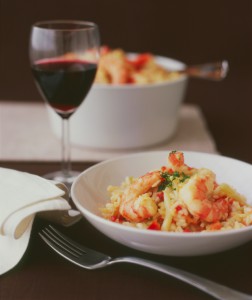Blind wine tastings should be simple – those tasting should not know the identity of the wines being tasted. When it comes down to blind taste testing for wine, there are 8 basic rules to always remember.
Rules for Blind Wine Tastings
- 6-12 people is the best for wine tasting. This way you only need one bottle per wine.

- Arrange the wine tasting so they are trying whites to red. From sweet to dry – light-bodied to full-bodied.
- Ask your guests not to wear perfumes or smoke.
- Bag or cover the bottles so they cannot be seen.
- Prepare a tasting note guide and answer sheet for your guests.
- Make sure you have crackers and a cheese platter, or some type of finger food.
- Supply plenty of water to drink between tastings.
- Use wine glasses, not paper or plastic.
Now you’ll have to decide what kind of blind tasting you would like to do. A Single-blind wine tasting is one varietal ie: Merlot, Chardonnay, Pinot Noir. The bottle should be covered, but you can see the wine in your glass.
A Double-blind wine tasting is where your guests will not know anything about the wine and they have to list its Varietal, Country and sometimes region.
And yes, there’s even a Triple-blind tasting where your guests are actually blind-folded and know absolutely nothing about the wine.
This will help you get started along hosting your own blind tasting party at home with friends and loved ones, but the most important rule not to forget is to just have fun!


 Brunch is my favorite meal, because there are so many choices in foods and wines. We always think of Champagne to pair with our Easter Brunch meal.
Brunch is my favorite meal, because there are so many choices in foods and wines. We always think of Champagne to pair with our Easter Brunch meal. increasingly well made with little or no oak. They drink well on their own, so they make excellent aperitifs, and they can double as unobtrusive accompaniments to seafood and light pastas at any time of year. Moreover, they are what I like to refer to as “no headache wines.” Without massive amounts of alcohol or layers of new oak, they are easy on my head as well as my palate. No wonder these wines are increasingly popular in Europe as well as America. Gavi from the Piedmont, Orvieto from Umbria, Verdicchio from a hand full of premium Verdicchio producers in the Marches, and Vernaccia from Tuscany are just a few of the Italian white wines I have especially enjoyed recently.
increasingly well made with little or no oak. They drink well on their own, so they make excellent aperitifs, and they can double as unobtrusive accompaniments to seafood and light pastas at any time of year. Moreover, they are what I like to refer to as “no headache wines.” Without massive amounts of alcohol or layers of new oak, they are easy on my head as well as my palate. No wonder these wines are increasingly popular in Europe as well as America. Gavi from the Piedmont, Orvieto from Umbria, Verdicchio from a hand full of premium Verdicchio producers in the Marches, and Vernaccia from Tuscany are just a few of the Italian white wines I have especially enjoyed recently.